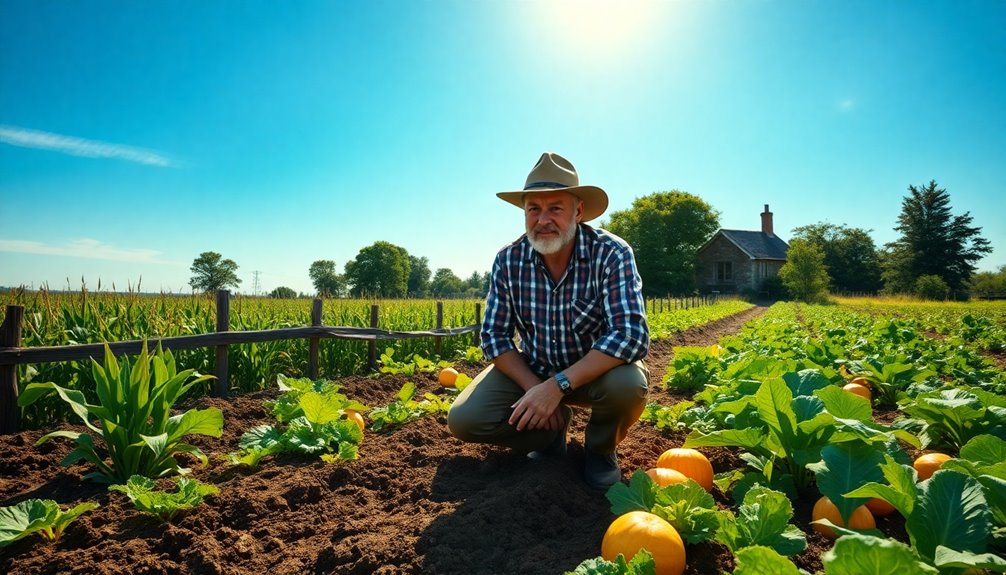Diversifying crops helps you build climate resilience by reducing the risk of total failure from pests, diseases, or extreme weather. Incorporate diverse varieties, including indigenous and heirloom types, which are adapted to your local environment. Use crop rotation, cover crops, and intercropping systems to improve soil health and fight pests naturally. If you’re interested, you’ll discover strategies tailored for smallholders and large farms that can strengthen your farming practices against climate stresses.
Key Takeaways
- Incorporate diverse crop varieties, including indigenous and heirloom species, to enhance resilience against pests, diseases, and climate stresses.
- Use crop rotation and polyculture strategies to improve soil health, reduce pest cycles, and spread production risks.
- Plant heat-tolerant, drought-resistant crops, and stagger planting times to adapt to changing weather patterns.
- Implement cover crops and legumes to fix nitrogen, conserve moisture, and protect soil from erosion.
- Support local knowledge, promote farmer training, and develop markets to facilitate crop diversification and long-term climate resilience.
The Importance of Crop Diversity in Climate-Resilient Agriculture
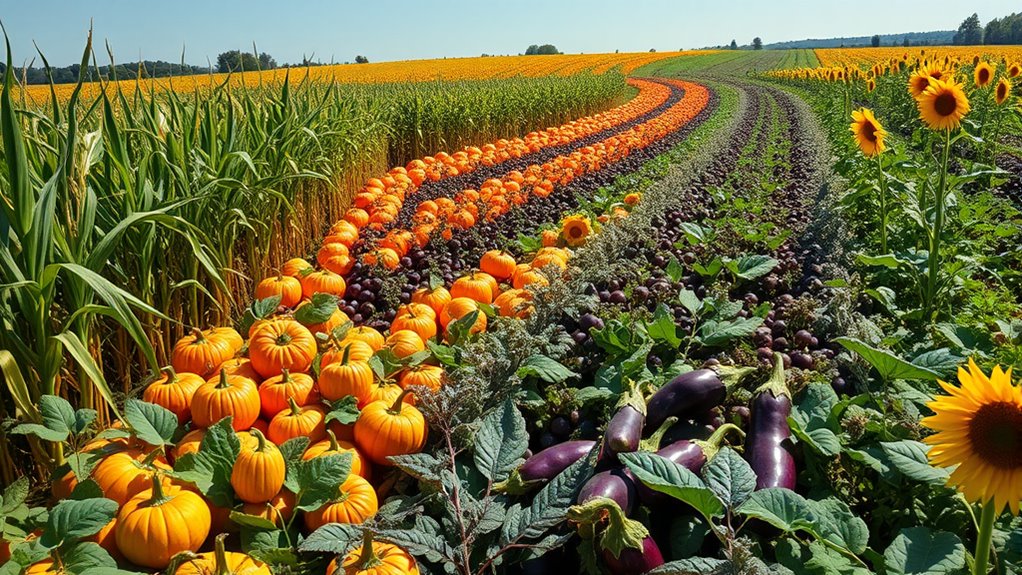
Climate change poses significant challenges to agriculture, making crop resilience more critical than ever. When you diversify your crops, you reduce the risk of total failure if one crop is hit by pests, diseases, or extreme weather. Different crops respond uniquely to environmental stresses, so having a variety means your farm can better withstand unpredictable conditions. This approach helps maintain steady yields and secure food supplies. Crop diversity also encourages healthier soil by promoting various nutrient cycles and reducing reliance on chemical inputs. By planting multiple crop types, you create a resilient farming system that adapts to changing climate patterns. Additionally, understanding the expiration of vape juice can be crucial when considering the shelf life of stored agricultural products or processed juices. Ultimately, diversifying your crops strengthens your farm’s stability and sustainability in the face of climate uncertainties.
Selecting a Variety of Crops for Different Climate Conditions
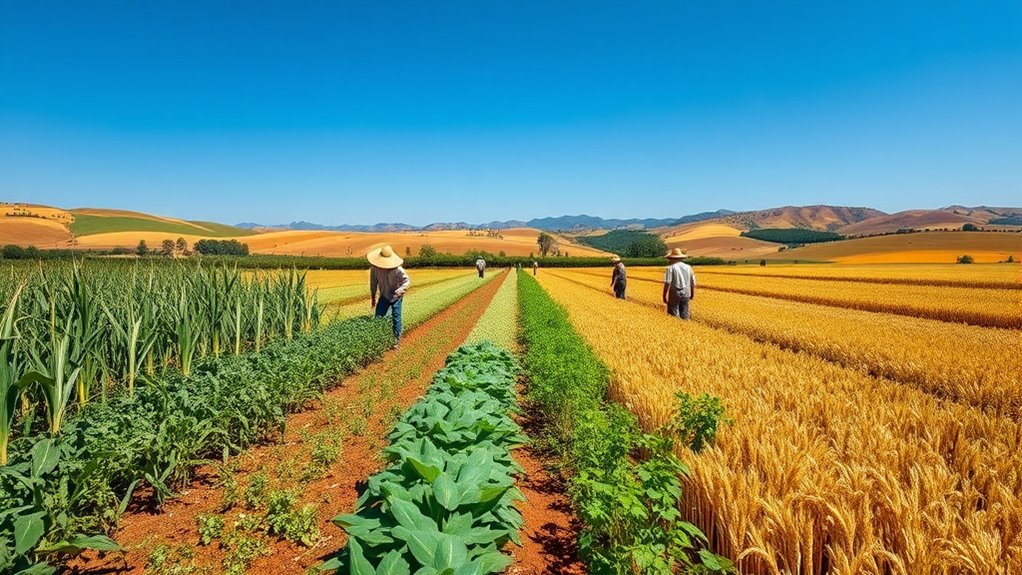
Choosing the right crops for varying climate conditions is key to building resilient farms. By using climate adaptation strategies, you can select varieties that thrive despite changes in temperature and rainfall. Incorporating diverse crops offers benefits like improved soil health and reduced risk of total crop failure. For example, integrating different crop types such as electric bike conversion kits can facilitate efficient transportation and farming practices in remote areas.
Climate Adaptation Strategies
To effectively adapt to changing weather patterns, farmers need to select a variety of crops suited to different climate conditions. This means choosing heat-tolerant varieties for hotter months and drought-resistant crops in areas prone to water shortages. Incorporate crops that mature at different times to spread risk and ensure continuous harvests despite unpredictable rainfall. Adjust planting dates to align with shifting seasons, and select hardy strains that can withstand extreme weather events. Using locally adapted varieties boosts resilience, as these crops are more likely to thrive under specific conditions. Diversifying your crop selection helps buffer against climate shocks, reduces dependency on a single crop, and improves food security. Additionally, understanding high refresh rates in crop growth cycles can optimize harvest timing and resource use. Tailoring your approach to your region’s climate is essential for sustainable, long-term farming success.
Crop Diversity Benefits
Implementing a variety of crops tailored to different conditions can substantially boost your farm’s resilience. When you diversify, you reduce risks tied to weather fluctuations, pests, and diseases that target specific crops. Different plants thrive under different conditions, so selecting a mix guarantees that some crops will succeed even if others fail. This approach stabilizes your yields and income, providing a buffer during adverse weather events. Crop diversity also improves soil health, as different plants contribute unique nutrients and organic matter. Additionally, diverse cropping systems attract a wider range of beneficial insects and pollinators, promoting a healthier ecosystem. Using farmhouse textiles and accessories in farm structures can also enhance the farm’s aesthetic appeal and functionality. Overall, diversifying your crops helps you adapt more effectively to climate variability, ensuring more consistent productivity and long-term sustainability.
The Role of Crop Rotation and Polyculture Systems

Implementing crop rotation and polyculture systems helps boost soil fertility naturally and reduces the need for chemical inputs. They also control pests and diseases more effectively by interrupting their life cycles. Plus, these practices can extend your growing seasons, giving you more flexibility and productivity. Incorporating educational and skill-building toys into agricultural training programs can further enhance farmers’ understanding of sustainable practices.
Enhancing Soil Fertility
Crop rotation and polyculture systems are powerful strategies for boosting soil fertility naturally. By alternating crops, you prevent nutrient depletion and break pest cycles, maintaining healthy soil. Polyculture diversifies plant roots, enhancing nutrient uptake and reducing erosion. Legumes, when included, fix nitrogen in the soil, reducing the need for chemical fertilizers. These systems improve soil structure, increase organic matter, and promote beneficial microbial activity. With diverse crops, you create a resilient ecosystem that sustains productivity over time. Additionally, soil microbial activity plays a crucial role in nutrient cycling and overall soil health. Here’s a quick overview:
| Crop Type | Nutrient Benefit | Example Crops |
|---|---|---|
| Legumes | Fix nitrogen | Beans, peas |
| Root Crops | Break up soil, add organic matter | Carrots, beets |
| Leafy Greens | Improve soil organic content | Spinach, lettuce |
| Grains | Add organic residues | Wheat, corn |
| Cover Crops | Protect soil, suppress weeds | Clover, vetch |
Pest and Disease Control
Have you ever wondered how farmers naturally reduce pests and diseases without relying solely on chemical controls? Crop rotation and polyculture systems are key strategies. First, rotating crops disrupts pest and disease life cycles, making it harder for them to establish. Second, planting diverse crops together confuses pests and attracts beneficial insects that prey on pests. Third, using a variety of plant types minimizes the spread of specific diseases, as pathogens usually target only certain crops. Additionally, understanding regional divorce statistics can help farmers plan crop rotations to avoid common crop failures. These practices improve plant health, reduce the need for chemical interventions, and promote a resilient farm ecosystem. By diversifying your crops, you create a natural barrier against pests and diseases, leading to healthier yields and a more sustainable farming approach.
Extending Growing Seasons
Extending growing seasons can substantially boost your farm’s productivity and sustainability. By implementing crop rotation and polyculture systems, you can make better use of available land and adapt to changing climate conditions. Rotating crops reduces soil exhaustion and pest buildup, allowing you to grow crops earlier or later in the year. Polyculture mixes species, creating a resilient system that withstands weather fluctuations. Consider this table to understand benefits:
| Crop Type | Growth Period | Benefits |
|---|---|---|
| Early crops | Spring | Extended harvest window |
| Cover crops | Off-season | Improves soil health |
| Main crops | Summer | Maximizes yield |
| Late crops | Fall | Extends income streams |
| Perennials | Year-round | Sustainable, low maintenance |
These strategies help you optimize your farm’s potential year-round, especially when considering climate resilience and sustainable practices.
Benefits of Indigenous and Heirloom Crop Varieties

Indigenous and heirloom crop varieties offer numerous benefits that often go unnoticed in modern agriculture. These crops are adapted to local environments, making them more resilient to pests, diseases, and climate fluctuations. By cultivating them, you can:
- Preserve genetic diversity, which strengthens overall crop resilience.
- Promote food security by reducing dependence on a few commercial varieties.
- Support local ecosystems and traditional farming practices.
- Enhance biodiversity, which is essential for creating a balanced and sustainable food system.
These varieties often require fewer chemical inputs and thrive with minimal intervention. Their unique flavors and nutritional profiles also enrich your diet. Embracing indigenous and heirloom crops helps build a more sustainable, resilient food system, especially essential in the face of climate change. You play a critical role in safeguarding agricultural diversity for future generations.
Integrating Cover Crops to Improve Soil Health and Diversity

Why is integrating cover crops an effective strategy for enhancing soil health and diversity? Cover crops protect the soil from erosion and improve its structure by adding organic matter. They also boost soil microbial activity, which supports nutrient cycling and suppresses pests. When you plant cover crops like legumes or grasses, you increase plant diversity, which benefits soil resilience against climate stresses. Cover crops can fix nitrogen naturally, reducing the need for synthetic fertilizers and improving overall fertility. They also help retain moisture and prevent compaction, making your main crops more productive. Using cover crop selection tailored to local conditions can optimize benefits and adaptability. By integrating cover crops into your farming system, you create a healthier, more diverse soil ecosystem that can better withstand droughts, floods, and other climate-related challenges. This approach is essential for building long-term climate resilience.
Strategies for Smallholder and Large-Scale Farmers
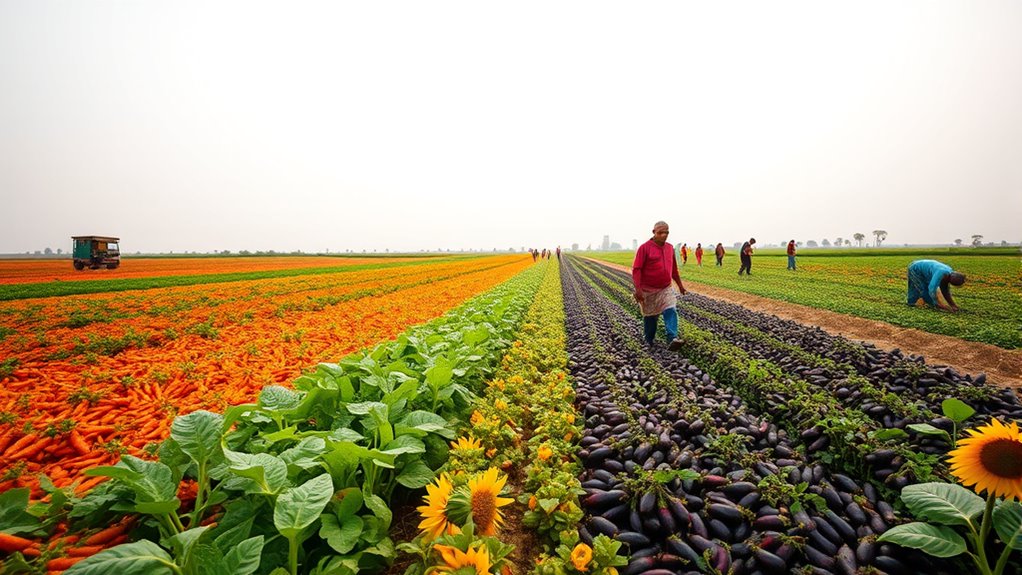
Implementing cover crops can be tailored to fit the needs of both smallholder and large-scale farmers, offering practical strategies for each. For smallholders, focus on affordable, easy-to-manage options like legumes or local varieties that improve soil fertility without extra costs. Large-scale farmers can invest in mechanized planting and diversified crop rotations to maximize land use and resilience. Consider these strategies:
- Adopt crop rotation plans that include diverse species to break pest cycles and boost soil health.
- Use cover cropping as a buffer during off-season periods, reducing erosion and maintaining soil moisture.
- Implement integrated pest management by combining cover crops with natural pest controls, lowering chemical use.
Both scales benefit from tailored approaches that enhance sustainability and climate resilience.
Challenges and Solutions in Implementing Crop Diversification
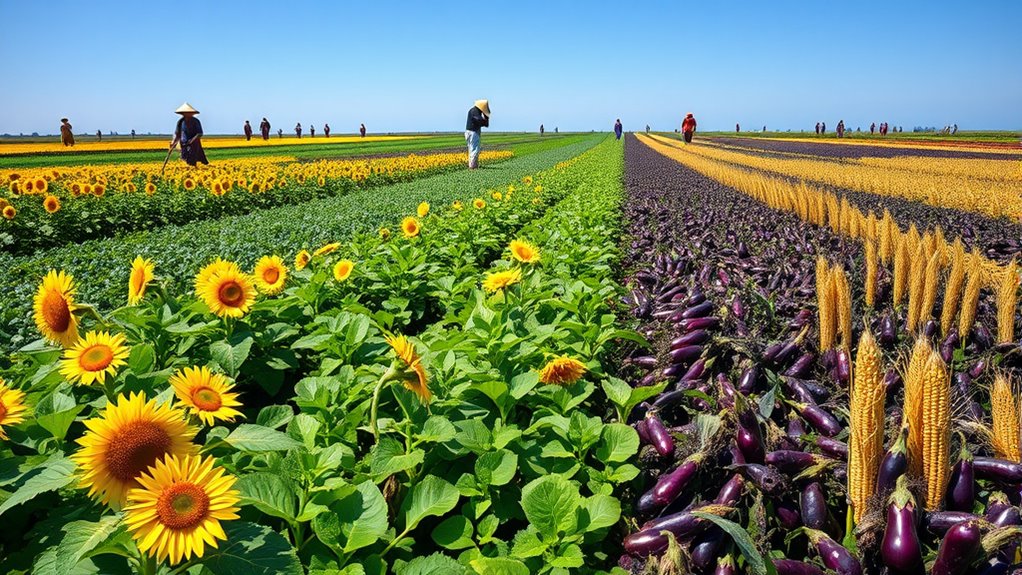
While crop diversification offers numerous benefits, farmers often face significant challenges when trying to adopt these practices. Limited access to information, unfamiliarity with new crops, and risk aversion can hinder progress. Additionally, infrastructure gaps and market uncertainty make it harder to diversify confidently. To visualize these hurdles, consider the table below:
| Challenge | Solution |
|---|---|
| Lack of technical knowledge | Training programs and extension services |
| Market access and demand | Developing local markets and value chains |
| Limited resources | Financial support and subsidies |
| Risk of reduced yields | Gradual integration and crop rotation |
Addressing these issues requires tailored solutions that build capacity, improve infrastructure, and create market opportunities, helping you successfully implement crop diversification.
Case Studies of Successful Crop Diversification Initiatives

Successful crop diversification initiatives demonstrate how farmers can transform challenges into opportunities by adopting innovative practices and building strong local networks. These case studies highlight real-world success stories that inspire action. For example:
Crop diversification turns challenges into opportunities through innovation and local collaboration.
- In Kenya, farmers introduced drought-resistant millet alongside maize, boosting yields during dry seasons.
- In India, a community adopted intercropping techniques, improving soil health and reducing pest issues.
- In Brazil, smallholders diversified crops to include fruits and nuts, increasing income and resilience to climate shocks.
These initiatives show that diversifying crops isn’t just sustainable; it’s profitable. By experimenting with different planting methods, collaborating with local organizations, and sharing knowledge, you can develop a resilient farming system that withstands climate variability and enhances food security.
Frequently Asked Questions
How Does Crop Diversification Impact Local Biodiversity?
Crop diversification boosts local biodiversity by creating varied habitats and offering different food sources for native species. When you plant multiple crop types, you reduce monoculture risks, encouraging a richer array of insects, birds, and other wildlife. This diversity helps maintain ecological balance, supports pollinators, and prevents pests from dominating. By diversifying your crops, you actively promote a healthier, more resilient ecosystem that benefits both agriculture and local wildlife.
What Are the Economic Risks of Crop Diversification?
You might think crop diversification always boosts your income, but it can actually pose economic risks. For instance, you could face higher initial costs for seeds, equipment, and training. Market fluctuations might make some crops less profitable, and you may struggle with finding buyers for diverse harvests. Additionally, shifting to new crops could disrupt existing supply chains or reduce economies of scale, creating financial uncertainties.
How Can Policymakers Support Diversified Farming Practices?
Policymakers can support diversified farming by providing financial incentives, such as grants or subsidies, to encourage farmers to adopt new crops. They should also invest in research and extension services that offer education on sustainable practices. Creating markets for diverse crops and implementing policies that protect farmers from market risks further motivates adoption. By fostering collaboration and offering technical support, policymakers help farmers build resilience and adapt to climate challenges effectively.
What Training Is Needed for Farmers to Adopt Crop Diversification?
You need training on selecting suitable crops for your region, understanding crop rotation, and managing diverse plantings effectively. Workshops on sustainable farming practices, pest control, and soil health are essential. Hands-on demonstrations help you learn new techniques, while access to resources like guides and expert advice boosts your confidence. Continuous education guarantees you stay updated on climate-smart practices, enabling you to diversify successfully and build resilience against climate impacts.
How Does Crop Diversity Affect Pest and Disease Management?
Crop diversity helps you manage pests and diseases more effectively by breaking up pest habitats and reducing the spread of any single issue. When you plant different crops, pests and diseases are less likely to thrive, as they often target specific plants. This natural balance lessens your reliance on chemical controls, lowers costs, and promotes healthier yields. Overall, crop diversity strengthens your farm’s resilience against biological threats.
Conclusion
By diversifying your crops, you build a more resilient and sustainable farm, capable of withstanding climate shocks. Embrace variety, rotation, and indigenous varieties to strengthen soil health and reduce risks. Remember, “Don’t put all your eggs in one basket”—diversification spreads your risks and boosts your farm’s future. Stay adaptable, keep learning, and you’ll cultivate not just crops, but lasting resilience for generations to come.



